Travel Log: Dipolog City
… Orchids capital of the Philippines
 ipolog is the capital of the province of Zamboanga del Norte on the southern Philippine island of Mindanao. Geographically, the city is surrounded by rolling hills to the southeast and the Sulu Sea to the north. Dipolog is known for its wild orchids and its sardine industry which stems from the rich fishing area off its shores. It is known as the "Gateway to Western Mindanao" through the Western Nautical Highway and has also been called the "Bottled Sardines Capital of the Philippines."
ipolog is the capital of the province of Zamboanga del Norte on the southern Philippine island of Mindanao. Geographically, the city is surrounded by rolling hills to the southeast and the Sulu Sea to the north. Dipolog is known for its wild orchids and its sardine industry which stems from the rich fishing area off its shores. It is known as the "Gateway to Western Mindanao" through the Western Nautical Highway and has also been called the "Bottled Sardines Capital of the Philippines."
HOW TO GET THERE
From Manila, Dipolog is just an hour by plane and from Cebu only thirty minutes also by plane. By sea, inter-island vessels regularly ply routes to Dipolog from Cebu, Dumaguete, Zamboanga and Manila. Roll on-roll off vessels ply the Dipolog-Dumaguete route several times a day. One can also travel by bus all over Mindanao from Dipolog. 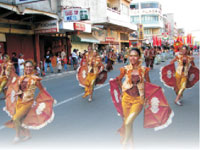
WHAT TO DO
Pagsalabuk Festival - that was an annual crowd drawer. Pagsalabuk is a "Subanen" term which means togetherness. The highlight of the festival is the street dancing which showcases the myriad interplay of cultures of the tri people of Mindanao - the Lumad, Moro and the settlers.
The festival usually starts on the 3rd week of April and culminates on the feast of Saint Vincent Ferrer celebrated every 3rd Saturday of May. Other festivals include the Katkat Sakripisyo sa 3003 Steps to Linabo Peak, a mountain climbing/trekking activity and "via cruces" which takes place every Good Friday of Lent.
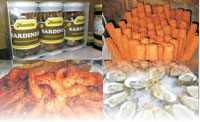 Other important activities include the Adlaw sa Dipolog, a celebration of the foundation day of Dipolog which falls on the 1st of July; Dahunog sa Dipolog, another festival that falls on the third week of September and culminates on the feast of Our Lady of the Most Holy Rosary on October 7. The highlight of the Dahunog Festival is the Parade Band competition and the Search for Ms. Teen Tourism; and another special event is the Pasko sa Dipolog (PASADI), a month- long display of Christmas decors and lights in strategic places of the city and nightly shows at the Dipolog Boulevard.
Other important activities include the Adlaw sa Dipolog, a celebration of the foundation day of Dipolog which falls on the 1st of July; Dahunog sa Dipolog, another festival that falls on the third week of September and culminates on the feast of Our Lady of the Most Holy Rosary on October 7. The highlight of the Dahunog Festival is the Parade Band competition and the Search for Ms. Teen Tourism; and another special event is the Pasko sa Dipolog (PASADI), a month- long display of Christmas decors and lights in strategic places of the city and nightly shows at the Dipolog Boulevard.
WHAT TO EAT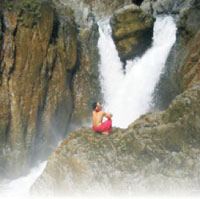
This progressive city has been considered by many individuals especially the foreigners, as an ideal place for retirement. Here, one can just walk to the malls and to the market to buy fresh fruits like mango, papaya, marang, durian, rambutan, lanzones and mangosteen. Fresh catch of seafoods such as shrimps, prawns, crabs, yellow fin tuna, shellfish, clams, oysters to name a few are abundant and available in the Central Market in very affordable prices. As well as bottled sardines, tinagaktak, bibingka and puto bumbong.
WHAT TO SEE
Sungkilaw Falls - The 3003 Steps to Linabo Peak is one of the favorites and desired destinations of our local and foreign tourist as it offers a fantastic view of the twin cities of Dipolog and Dapitan, the sky, plains and sea horizon after trailing the 3003 concrete steps wind along the tunnels of verdant trees.
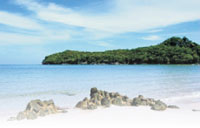 Cogon Eco-Park - a 344 hectares reforestation area situated in Barangay Cogon established in 1958. Tourists who visited the area were all amazed gazing the matured trees growing wild with different species like Mahogany, Teak, Yemane, Lumbayao, Molave, Acacia, Narra, Mayapis, Lauan, Narig, Tianong, Duguan, Lumbayao, Rattan and Nato.
Cogon Eco-Park - a 344 hectares reforestation area situated in Barangay Cogon established in 1958. Tourists who visited the area were all amazed gazing the matured trees growing wild with different species like Mahogany, Teak, Yemane, Lumbayao, Molave, Acacia, Narra, Mayapis, Lauan, Narig, Tianong, Duguan, Lumbayao, Rattan and Nato.
Dakak Beach Resort - unwinding while tasting sweet mango and fresh coconut juice.
Sicayab Beach - is a 7- kilometer stretch of fine gray sand. It's just 4 kilometers away from the city proper and is a favorite haven of holiday and weekend crowd. It is accessible by motor cabs. 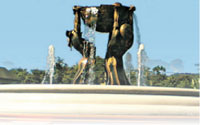
Estaka-Turno Y junction Fountain - the statutes represent the tri-people of Mindanao, which symbolize the diverse cultures prevailing in Dipolog. The bowl raised to heavens is a gesture of thanksgiving and offering to God Almighty for the generous outpouring of graces and blessings, bountiful harvests and sustained peace and prosperity.
For more information, check out www.allbestofphilippines.blogspot.com, www.drhostel.com, or www.dipologcity.org
